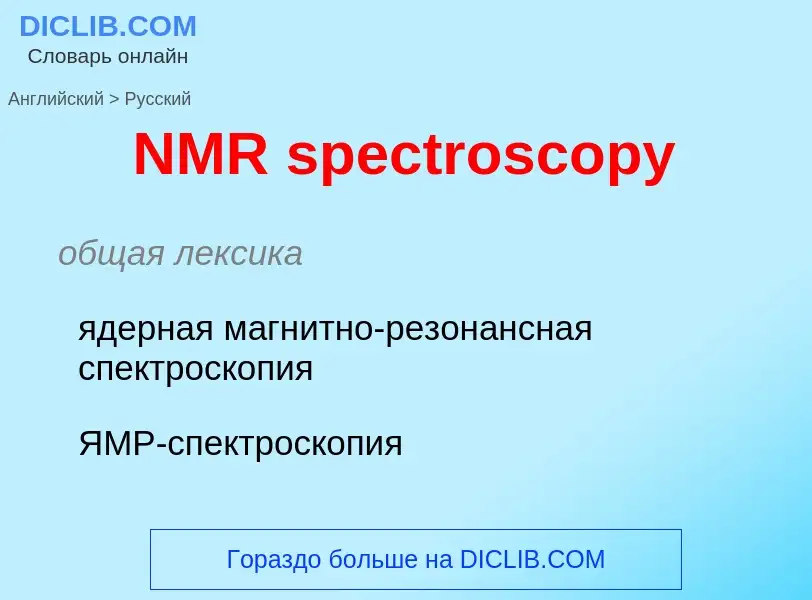Μετάφραση και ανάλυση λέξεων από την τεχνητή νοημοσύνη ChatGPT
Σε αυτήν τη σελίδα μπορείτε να λάβετε μια λεπτομερή ανάλυση μιας λέξης ή μιας φράσης, η οποία δημιουργήθηκε χρησιμοποιώντας το ChatGPT, την καλύτερη τεχνολογία τεχνητής νοημοσύνης μέχρι σήμερα:
- πώς χρησιμοποιείται η λέξη
- συχνότητα χρήσης
- χρησιμοποιείται πιο συχνά στον προφορικό ή γραπτό λόγο
- επιλογές μετάφρασης λέξεων
- παραδείγματα χρήσης (πολλές φράσεις με μετάφραση)
- ετυμολογία
NMR spectroscopy - translation to Αγγλικά
общая лексика
ядерная магнитно-резонансная спектроскопия
ЯМР-спектроскопия
синоним
общая лексика
спектроскопия протонного магнитного резонанса
медицина
магнитно-резонансная спектроскопия
Ορισμός
Βικιπαίδεια

Nuclear magnetic resonance spectroscopy, most commonly known as NMR spectroscopy or magnetic resonance spectroscopy (MRS), is a spectroscopic technique to observe local magnetic fields around atomic nuclei. This spectroscopy is based on the measurement of absorption of electromagnetic radiations in the radio frequency region from roughly 4 to 900 MHz. Absorption of radio waves in the presence of magnetic field is accompanied by a special type of nuclear transition, and for this reason, such type of spectroscopy is known as Nuclear Magnetic Resonance Spectroscopy. The sample is placed in a magnetic field and the NMR signal is produced by excitation of the nuclei sample with radio waves into nuclear magnetic resonance, which is detected with sensitive radio receivers. The intramolecular magnetic field around an atom in a molecule changes the resonance frequency, thus giving access to details of the electronic structure of a molecule and its individual functional groups. As the fields are unique or highly characteristic to individual compounds, in modern organic chemistry practice, NMR spectroscopy is the definitive method to identify monomolecular organic compounds.
The principle of NMR usually involves three sequential steps:
- The alignment (polarization) of the magnetic nuclear spins in an applied, constant magnetic field B0.
- The perturbation of this alignment of the nuclear spins by a weak oscillating magnetic field, usually referred to as a radio-frequency (RF) pulse.
- Detection and analysis of the electromagnetic waves emitted by the nuclei of the sample as a result of this perturbation.
Similarly, biochemists use NMR to identify proteins and other complex molecules. Besides identification, NMR spectroscopy provides detailed information about the structure, dynamics, reaction state, and chemical environment of molecules. The most common types of NMR are proton and carbon-13 NMR spectroscopy, but it is applicable to any kind of sample that contains nuclei possessing spin.
NMR spectra are unique, well-resolved, analytically tractable and often highly predictable for small molecules. Different functional groups are obviously distinguishable, and identical functional groups with differing neighboring substituents still give distinguishable signals. NMR has largely replaced traditional wet chemistry tests such as color reagents or typical chromatography for identification. A disadvantage is that a relatively large amount, 2–50 mg, of a purified substance is required, although it may be recovered through a workup. Preferably, the sample should be dissolved in a solvent, because NMR analysis of solids requires a dedicated magic angle spinning machine and may not give equally well-resolved spectra. The timescale of NMR is relatively long, and thus it is not suitable for observing fast phenomena, producing only an averaged spectrum. Although large amounts of impurities do show on an NMR spectrum, better methods exist for detecting impurities, as NMR is inherently not very sensitive - though at higher frequencies, sensitivity is higher.
Correlation spectroscopy is a development of ordinary NMR. In two-dimensional NMR, the emission is centered around a single frequency, and correlated resonances are observed. This allows identifying the neighboring substituents of the observed functional group, allowing unambiguous identification of the resonances. There are also more complex 3D and 4D methods and a variety of methods designed to suppress or amplify particular types of resonances. In nuclear Overhauser effect (NOE) spectroscopy, the relaxation of the resonances is observed. As NOE depends on the proximity of the nuclei, quantifying the NOE for each nucleus allows for construction of a three-dimensional model of the molecule.
NMR spectrometers are relatively expensive; universities usually have them, but they are less common in private companies. Between 2000 and 2015, an NMR spectrometer cost around 500,000 - 5 million USD. Modern NMR spectrometers have a very strong, large and expensive liquid helium-cooled superconducting magnet, because resolution directly depends on magnetic field strength. Less expensive machines using permanent magnets and lower resolution are also available, which still give sufficient performance for certain applications such as reaction monitoring and quick checking of samples. There are even benchtop nuclear magnetic resonance spectrometers. NMR can be observed in magnetic fields less than a millitesla. Low-resolution NMR produces broader peaks which can easily overlap one another causing issues in resolving complex structures. The use of higher strength magnetic fields result in clear resolution of the peaks and is the standard in industry.





![<sup>1</sup>H NMR spectrum of [[menthol]] with [[chemical shift]] in ppm on the horizontal axis. Each magnetically inequivalent proton has a characteristic shift, and couplings to other protons appear as splitting of the peaks into multiplets: e.g. peak ''a'', because of the three magnetically equivalent protons in methyl group ''a'', couple to one adjacent proton (''e'') and thus appears as a doublet. <sup>1</sup>H NMR spectrum of [[menthol]] with [[chemical shift]] in ppm on the horizontal axis. Each magnetically inequivalent proton has a characteristic shift, and couplings to other protons appear as splitting of the peaks into multiplets: e.g. peak ''a'', because of the three magnetically equivalent protons in methyl group ''a'', couple to one adjacent proton (''e'') and thus appears as a doublet.](https://commons.wikimedia.org/wiki/Special:FilePath/Menthol Proton Spectrum.jpg?width=200)
